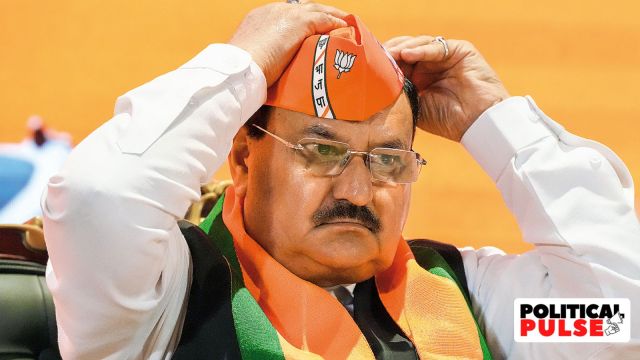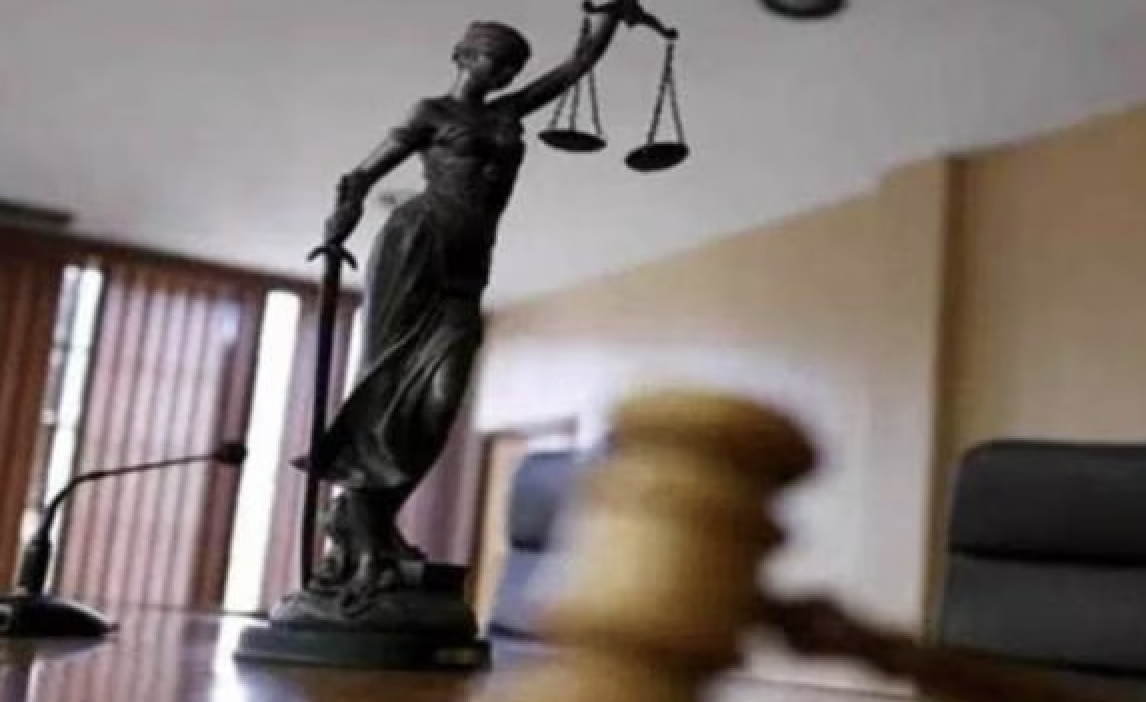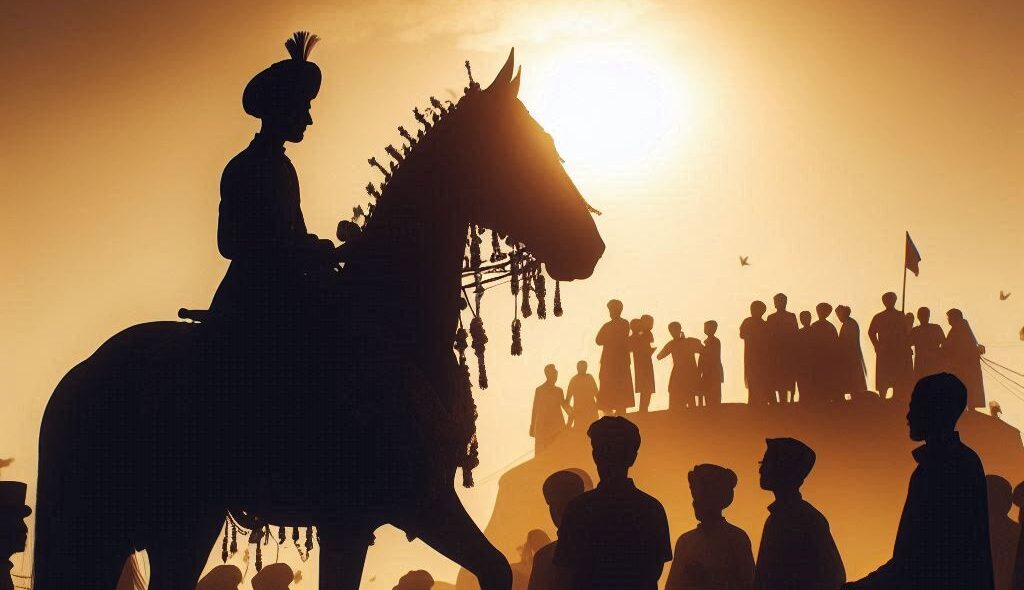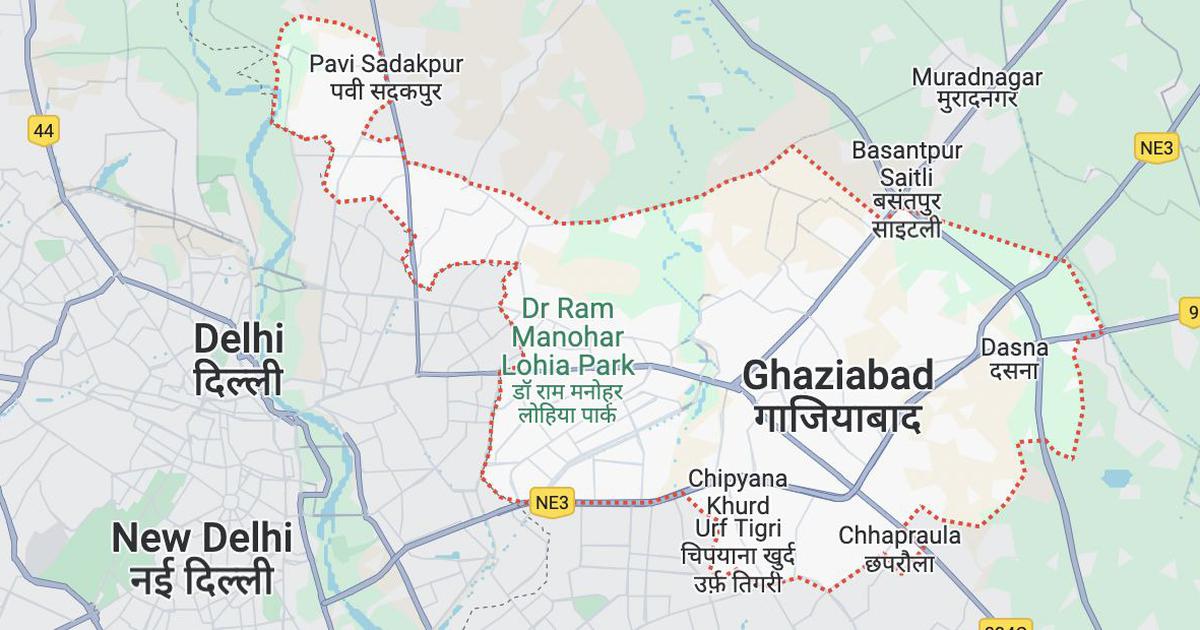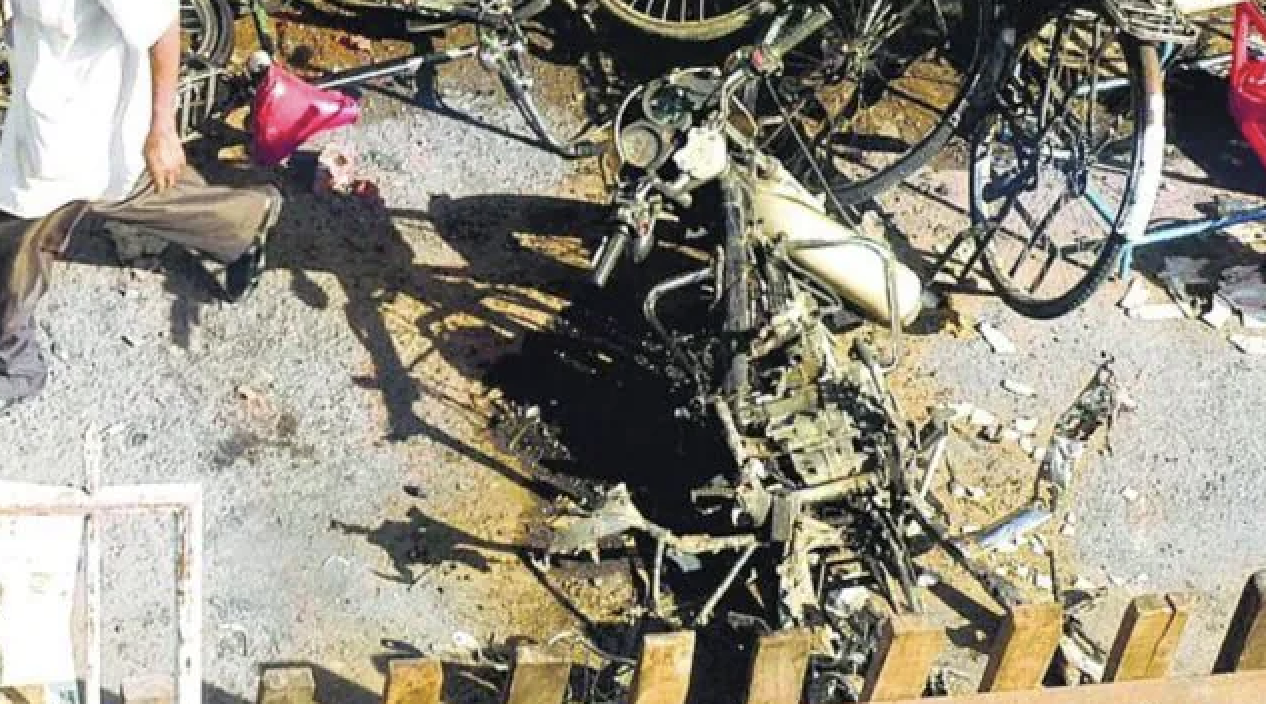
Dasna/Meerut/Haridwar: There is one thing that many residents, Hindu and Muslim, of Dasna in Uttar Pradesh’s Ghaziabad district can agree upon — their town has changed ever since Yati Narsinghanand Saraswati took over as the mahant (head priest) of Dasna Devi Temple, over a decade ago.
Last week, Narsinghanand, who is also the mahamandaleshwar (leader) of the influential Juna akhara (monastic order), was arrested from the banks of the Ganga in Haridwar for a December speech at a Dharam Sansad (religious congregation), in which he called for Hindus to take up arms against Muslims. He was also booked for making “objectionable” remarks about women, and sent to 14 days in judicial custody.
So far, very few allegations have stuck to the priest, even though he has been named in multiple FIRs in rioting and hate speech cases in the Dasna-Ghaziabad belt. He has been arrested twice before, but managed to get bail each time. Indeed, Narsinghanand’s vitriolic speeches have garnered him quite a fan following as well as patronage from a section of Hindutva politicians.
But it is in Dasna where Narsinghanand’s influence is most obvious, especially in a prominent board placed at the temple’s entrance that warns: “Ye mandir Hinduon ka pavitra sthal hai, yahan Musalmanon ka pravesh varjit hai (This temple is a holy place for Hindus, Muslims are forbidden from entering).”
Visitors have to show a valid identity card to a policeman stationed outside before they can enter the temple — said to be almost a century old — which once allowed in people of all religions. Last March, one of Narsinghanand’s disciples brutally beat a 14-year-old Muslim boy who had come in to drink some water.
Since August last year, over a dozen Uttar Pradesh police personnel have been deployed to provide round-the-clock security at the temple, although not to protect hapless Muslim youth who might wander in but to guard Narsinghanand after an incident in which a priest was stabbed at the temple.
Some local residents are pleased that Narsinghanand has brought the otherwise nondescript temple into the limelight with his speeches and YouTube videos, some of which have called for the genocide of Muslims or described them as jihadis intent on turning India into an Islamic state. People are now coming from far and wide for tutelage from the head priest.
One such disciple is 27-year-old Krishna Ballabh Bhardwaj, a mechanical engineer by profession, who has been living in the Dasna Devi temple for the past one year or so. “I used to watch his videos in college and liked them. After finishing college, I joined a private company in Noida where I first met Guruji. I decided then that I will become his disciple for life and came to Dasna,” Bhardwaj told ThePrint.
However, Muslims in the area are feeling threatened and some Hindus, too, are having second thoughts about Narsinghanand’s “extremist” speeches.
ThePrint spoke to several residents of Dasna, Narsinghanand’s associates, and his father Rajeshwar Dayal Tyagi to trace the evolution of a Moscow-educated engineer into a hard-line religious ideologue, as well as the impact he has had on this small UP town.
‘A bright student, started a catering service in Moscow’
ThePrint met Narsinghanand’s father, 83-year-old Rajeshwar Dayal Tyagi, at his modest one-storey house in Meerut, where he lives with his 106-year-old mother and the family of his younger son. Narsinghanand’s wife also lives in this house, but said she did not wish to be interviewed in order to protect her privacy.
Tyagi, a retired official of the defence accounts department (under the Defence Ministry), told ThePrint that Narsinghanand’s given name was Deependra Narayan Singh and that he was born in 1972 at Hirnot village, Bulandshahr. Singh and his four younger siblings had a typical upbringing, Tyagi said. According to him, Narsinghanand was a bright student but always had a religious streak.
“He got first class throughout his school years. Nobody could beat his record. He was very good in maths,” Tyagi said. “As a young boy, Deependra was also religious. He used to eat only after taking a bath and doing his puja, a habit that he has continued in later years too.”
Tyagi told ThePrint that Singh completed his schooling from Tarachand Inter College in Hapur, where he lived with an aunt’s family. Soon after he passed class 12, an opportunity to go abroad, to the then USSR, arose.
“There was this Indo-Soviet Culture Association, which offered scholarships to meritorious students for studying in Russia. Deependra got a scholarship to study food and chemical technology from Moscow’s State Academy Chemical and Machine Building,” Tyagi said.
In 1991, Singh flew out to Moscow for the BTech and MTech course, where he continued to do well in studies, his father said.
Arun Tyagi, a resident of Hapur, who was also Singh’s junior at the Moscow institute, said he was very popular among the Indian student community, especially because of his culinary expertise.
“He was my guruji. He started a small catering service… cooking home-made Jain food for the Indian students. The food was free for students though we charged money from businessmen who ordered from us,” Arun Tyagi, who lived in the same hostel as Singh, told ThePrint.
When asked about whether he is still in close contact with Deependra Singh aka Narsinghanand, Arun Tyagi said that he still considered him a friend.
“He is a friend, but we lead our separate lives. I agree with some of his views but that’s about it,” he said, adding, “We had a small circle of friends who studied in Moscow and after returning to India, we met once in a while. He is very helpful and I know if ever needed, he will be there to support me.”
From ‘family man’ to religious ideologue
According to Rajeshwar Tyagi, Singh returned to India in 1997 to get married. “His mother was not keeping well and we wanted him to marry before anything happened to her. It was an arranged marriage, but he liked the girl,” Tyagi said, adding that Singh’s mother passed away in 2003.
“After returning, he got a job offer from Haldiram’s (the popular food chain) in Rajasthan. He was offered Rs 30,000. At that point of time, he was among a handful who had a food engineering degree from Moscow,” recalled his father.
Singh did not take the offer. He instead went to Ghaziabad and opened a coaching institute, where he taught computer science and mathematics.
Tyagi told ThePrint that it was around this time, in the mid-2000s, that Singh came in contact with the senior BJP leader Baikunth Lal Sharma aka Prem, a two-time MP from North-East Delhi. Sharma (who passed away in 2019) was known as a giant slayer for defeating Congress heavyweight H.K.L. Bhagat in 1991. He was also a radical Hindutva ideologue and played a prominent role in the Ram Mandir movement.
“My son used to attend programmes where Premji spoke and got inspired by his preachings, especially the hard anti-Muslim stand. He became his follower. In a way, Premji was my son’s mentor and it was he who shaped his views on Muslims,” Tyagi said.
Indeed, when Narsinghanand became the head priest of Dasna Devi Temple, he erected a bust of Prem Sharma, with a plaque mentioning his role in the Ram Janmabhoomi movement, in a corner of the main meeting hall inside the temple. This room also has murals depicting how Muslims allegedly tormented Hindus over the generations.
Narsinghanand himself has, however, claimed that his anti-Muslim stand stemmed from a personal experience that he had gone through.
In an interview to ThePrint in October 2019, Narsinghanand claimed his attitude towards Muslims changed when a girl from a Ghaziabad college blamed him for not protecting her from his Muslim friends who were harassing her. In the same interview, Narsinghanand claimed that he joined the youth brigade of the Samajwadi Party (SP).
ThePrint was not able to independently verify Narsinghanand’s ties with the SP, but Rajeshwar Tyagi told ThePrint that his son was affiliated with the party until “differences” grew around 2005 when the SP started building the Ala Hazrat Haj House in Ghaziabad. Singh apparently “sat outside the Ghaziabad collectorate, protesting against the construction”, his father said.
Soon afterwards, Singh quit his political activities and also gave up family life. He took sanyas (renunciation) and took the title of Yati Narsinghanand Saraswati.
His father recalled this period: “He stopped coming home after taking sanyas and started wearing saffron robes. He started making videos of his preachings and speaking at religious congregations.”
According to Rajeshwar Tyagi, Narsinghanand’s wife and daughter (who lives in another state) still visit him at the Dasna Devi temple sometimes. “But we live our own separate lives now,” he said. “I too wanted him to be my support in old age. But if someone does not listen, what do you do? We can’t stop living our lives. Now, I am the guardian of this clan,” he added.
Tyagi said he has tried speaking to his son about his hostile speeches, but to no avail.
“I have told him that you are a sadhu, such aggression, such hatred does not suit a sadhu. There are terrorists who are Muslims but that does not mean all Muslims are terrorists. But who is listening? He is a grown-up individual,” he said.
He added that Narsinghanand has made efforts to make Hindus feel “safer” in Dasna. “The Dasna Devi Temple did not have a boundary wall. He got a wall constructed, whatever improvement took place in the temple happened during his time,” he said.
How exactly Narsinghanand landed in Dasna and became head priest is not entirely clear, but there are some clues.
A ‘dabang’ leader who changed Dasna
Satyender Chauhan, a former BJP municipal councillor from Dasna, told ThePrint that he and a few other prominent elders of the town brought in Narsinghanand as head priest in 2007.
According to Chauhan, the temple and surrounding areas were very “unsafe” at the time and there had been instances of looting from the premises. There was a need, Chauhan said, for a “dabang (fearless)” leader and Narsinghanand fit the bill.
“I had heard his strong speeches in Ghaziabad. He was popular among youth and his organisational capabilities were good. We thought he would manage and protect the temple, which is surrounded by Muslim localities,” Chauhan said.
The area was never the same again, but local residents differ in their opinions about the direction of the change. Some say that Dasna has been altered for the better, while others believe the opposite.
Mohini Chaturvedi, a 27-year-old housewife and a resident of DCM Colony, who had come to pray at the Dasna Devi Temple Sunday, told ThePrint that she felt “protected” by Narsinghanand. “We don’t feel safe walking alone in Muslim localities. Swami ji has taken them [Muslims] on openly. I feel protected and safe in Swami ji’s presence. Other Hindus feel the same here but don’t say this openly fearing a backlash from the Muslims,” she said.
However, some Hindu residents who initially were in favour of Narsinghanand are no longer so enthused about him.
Satish Sharma, who lives in the lane just opposite the temple, told ThePrint that the temple has been attracting “anti-social elements” of late.
“His followers roam around the temple premises brandishing guns. He recently got a gym built inside the temple premises, where outsiders come and practice,” he said. We supported him initially. But after four or five years, when we saw his extremist nature, we distanced ourselves,” Sharma said.
Narsinghanand’s followers say the guns in question are licensed and intended to protect residents, but Muslims living nearby told ThePrint they do not feel safe and are disturbed by how polarised the community has become.
Dilshad Qureshi, a resident of Doodhiya Peepal Chauraha who runs one of the oldest sweet shops in the area, said that his family had helped renovate the Dasna Devi Temple and were hurt that they could not enter it any longer.
“We are third-generation Muslims living here. When I was a child, I remember going to the Dasna Devi Temple during Sherawali Jhanki. My family had helped in renovating the temple. And now they have put up a board saying Muslims can’t enter. Why?” Qureshi asked.
Naeem Saifi, a 40-year-old carpenter, who lives near the Telio Wali Mosque in Dasna, also remembers a time when Hindus and Muslims lived together harmoniously. “We grew up here. Even after the Babri Masjid was demolished, Hindus and Muslims have lived alongside each other,” Saifi said.
He pointed to the Shri Pipleshwar Mahadev Mandir nearby. “That temple is just 200 metres away from the Telio Wali Mosque. They are coexisting without any disturbance. There is no poster banning Muslims here,” he said.
One thing that Muslims and Hindus can agree on is that both communities have become polarised.
A senior police officer who was earlier posted in Meerut and handled Dasna told ThePrint that the law-and-order situation had worsened.
“There has been a spurt in crime in the area. It’s a fact that the atmosphere has become very volatile because of the animosity between the two communities,” the police officer said on the condition of anonymity.
Powerful supporters?
During the Haridwar religious congregation where hate speeches were made, one of the attendees was former Delhi BJP spokesperson Ashwini Upadhyay, who subsequently distanced himself from the event saying he was there only briefly.
However, while the BJP brass has generally kept itself at a safe length from Narsinghanand, his supporters claimed that local BJP candidates often enlisted the head priest’s help for campaigns.
Anil Yadav, manager of Dasna Devi temple, who now calls himself “Chhota (Little) Narsinghanand”, said that “many BJP candidates who went on to become MLAs” took Narsinghanand’s help in their campaigns. According to some news reports, Aligarh MLA Anil Parashar also attended an event in support of Narsinghanand this month.
Former municipal councillor Satyender Chauhan told ThePrint that Sadhvi Pragya Thakur visited Dasna last month. “She had taken Guruji to Bhopal for campaigning during 2019 parliamentary elections, Giriraj Singh had taken him to Begusarai for campaigning, when he was contesting from the seat in 2019,” Chauhan claimed. He has many ardent followers in VHP also, his followers have said.
What is undeniable is that Narsinghanand is one of the most powerful sadhus in India. Last year, he was anointed as the mahamandaleshwar of the Juna akhara, which is believed to be the most important among the 13 akharas or Hindu monastic orders in the country.
He was also the main organiser of the infamous Dharam Sansad in Haridwar in December, where he gave a call to Hindus to take up arms against Muslims.
However, the sadhu community in Haridwar seems divided now that Narsinghanand has been arrested. While a section of seers behind the Dharam Sansad are demanding his release, others have maintained a distance.
Anand Swarup Bharti, head of Shambhavi Dham and president of the Shankaracharya Parishad, a religious body in Haridwar, told ThePrint he supported Narsinghanand.
“Yati Narsinghanand is our pride. He does not want India to become an Islamic state. What is wrong with that?” Bharti said.
This story first appeared on theprint.in


